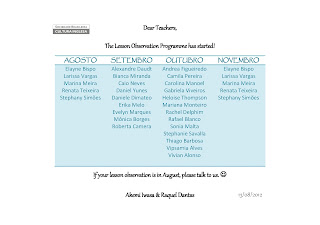Tuesday, August 7, 2012
Tuesday, December 6, 2011
Easy busy? Yes, for this group everything is easy busy. Well, we have to admit that it was hard to choose a theme for the post, but once they decided… everything was fine. And they had so much fun preparing the post and then sharing it with their friends.
Of course, these guys wanted to win, so marketing was really important: they had a campaign on facebook and at school, which meant annoying their friends to make them comment on their post. And it worked!
More important than winning, what really matters is their interest and dedication. The blog became an everyday concerning and it made them have more contact with English. Most important: they became closer to each other. This blogject bounded the students together and helped improve their English.
However, we have to say some things about them: do you know that they love laughing at the teacher when she says “So far, so good”? And every lesson they insist on playing Electric Chair or Stop; one of the students almost hurt the teacher (and the ex-teacher) trying to perform a break dance.
Guys, congratulations on the blogject. You deserved it because you are excellent students and wonderful people. U R GR8!
Tuesday, November 29, 2011
BLOGJECT WINNERS
Tuesday, November 22, 2011
Simple ways to help the environment
Anaerobic Biodigestor
Anaerobic Biodigestor is an equipment used for the production of biogas, a mixture of gases - about 75% methane and 25% Co2 produced for bacteria that digest organic substance in anaerobic conditions (that is, in oxygen absence). A biodigestor is nothing more than a chemical reactor where the chemical reactions have biological origin. Biogas can be used:
1) as combustible in substitution of the natural gas or the Gas Liquefied Petroleum (GLP), both extracting of mineral reserves.
2) to cook in agricultural residences next to the production place (saving other power plants, as mainly firewood or GLP).
3) in the agricultural production as, for example, in the heating of installations for very sensible animals to the cold (pigs up to 15 days of age, for example) or in the heating of greenhouses of vegetal production.
Green Roof
Green roof is a viable and sustainable alternative in relation to the traditional roofs and slabs, as it facilitates the management of large loads of storm water, improving thermal, environmental services and new recreation areas. The green roof also provides a much cooler environment than other roofs, keeping the building protected from extreme temperatures, especially in summer, reducing up to 3 ° C. In artificial environments such as urban environmental, it promotes rebalancing, bringing the benefits of vegetation for public health and biodiversity.
The green roof also keeps the relative humidity of air through the surroundings of the building, forms a microclimate and purifies the atmosphere surrounding the building, forming a micro ecosystem. It contributes to the combat of the greenhouse effect, increasing the 'kidnapping' (withdrawal) of carbon from the atmosphere and at the same time brings more harmony, wellness and beauty for residents and / or occupants of the building, as we can see in the picture below.
Hoods
They're a wind system that is designed to industry, agricultural warehouses, gyms and any other environment where a continuous exchange of air is necessary.
They're driven by the force of the wind or by convection and they accommodate the internal and external temperatures of the environment and especially the renewal of the ambient air.
They aren't noisy, they operate uninterruptedly and there’s no maintenance cost. It’s a low cost alternative for energy savings and immediate amortization.
Water reuse
Water is used in an inconsequential way every day. Through much time in the bath, lots of rinses in the washing machine, the tap running when washing dishes and vegetables. Likewise, Brazilian industry generates highly polluted water in production processes without showing concern for water resources. The question is: why don’t we take advantage of this water?
This question is already part of some housewives day-to-day, using the water resulting from washing machine to flush, wash sidewalks, bathroom and other rooms of a house. The industry is also waking up to the water reuse. The main advantage is the savings of up to 70% of spending on water, according to AGCO in Brazil.
What about you? What do you do to help the environment?
YE1 - Tue/Thu 17:00h
teacher: Evelyn Marques
Thursday, November 17, 2011
Sustaintability: a hero or a villain?
What is Sustaintability?
It is a group of actions that people can do to help the world, for example: Recycling, saving energy, water, etc ...
- What companies are doing...
* Being sustainable is now a business for a lot of companies. Some companies don't really help the environment, but they want a place in the market.
* Some companies promise to be sustainable, for example, to plant eucalyptus trees to make school materials, but these trees harm the soil for ten to fifteen years.

Sustaintability: Sustains the planet or the companies?
What do you think? Leave a comment!
C1 - T/T 11h - Gabriela Viveiros
Wednesday, November 16, 2011
Cute Animals
We think animals are cute and we love them. Look at these pictures and fall in love with cute animals.
Animals are cute...
and funny.
They are lovely...
and good friends.
They can be white...
...brown...
...or colorful.
We love them and they love us.
Take care of them and save the planet!
B1 - Mon/Wed - 2:15 pm - Vanessa Ferreira
Wednesday, November 9, 2011
Money Talks
Today we talk about consumerism, ecology and global warming. Consumerism is the habit of buy a lot just to buy, produce in excess, use water in excess, use energy in excess... Who never listened “Let’s go shopping” any time?
The consumerism is linked with global warming; when we produce a lot, we produce more trash. The trash pollutes: oceans, rivers, streets, etc. We need buy things, It’s necessary for our life, but when we use it in excess we have a lot of consequences. The man cuts a lot of trees to produce anything and that have consequences like the death of a lot of animals.
Save our planet. We have time.
YE1; Mon-Wed; 09:30; Rafael Blanco
Subscribe to:
Posts (Atom)

















